Are you considering getting a dog, but don’t think you can handle the fur? Then a hairless dog breed may be perfect for you! These dogs come in a variety of shapes and sizes, and they make great pets for people of all ages.
The hairless dog breed, characterized by its lack of fur, is a unique and distinct group of canine breeds that have captured the attention and curiosity of dog enthusiasts worldwide. These breeds, such as the Chinese Crested, Xoloitzcuintli, and Peruvian Inca Orchid, stand out due to their striking appearance and minimal grooming needs.
One of the pros of owning a hairless dog is their hypoallergenic nature, making them suitable for individuals with allergies. Additionally, their lack of fur means less shedding and a reduced risk of flea infestations.
However, there are some cons to consider when it comes to hairless dog breeds. Without fur to protect them, they are more susceptible to sunburn and extreme temperatures. Owners must take extra care to provide them with adequate sun protection and warmth during colder months. Additionally, their exposed skin requires regular moisturizing to keep it healthy and protected.
When it comes to grooming, hairless dog breeds require special care. Regular bathing is necessary to prevent skin issues, and moisturizers or oils should be applied to keep their skin hydrated. Their teeth also require regular brushing to maintain oral health.
In terms of health concerns, hairless dog breeds may be more prone to skin infections, allergies, and dental issues. Regular check-ups with a veterinarian are essential to catch and address any potential health problems early on.
Despite these considerations, hairless dog breeds have gained popularity among dog lovers due to their unique appearance and low grooming needs. By providing them with the proper care, these hairless companions can thrive and bring joy to their owners.
Hairless dog breeds distinguish themselves from other dog breeds through their unique lack of fur, setting them apart in terms of appearance and grooming needs. One of the most notable distinctions is their unique grooming requirements. Without fur, hairless dogs have different skin care needs compared to their furry counterparts. They require regular moisturizing and sunscreen application to protect their sensitive skin from sunburn and dryness. Additionally, their lack of fur makes them hypoallergenic, as they do not shed hair and dander like other breeds, making them suitable for people with allergies.
Another distinguishing factor is their ability to regulate body temperature. Without fur to provide insulation, hairless dogs may struggle to stay warm in colder temperatures and are more prone to sunburn in hot weather. Owners need to take extra precautions to keep them comfortable in extreme climates.
Hairless dog breeds also have unique health considerations. Their lack of fur exposes their skin to potential injuries, such as cuts and scrapes. Regular vet check-ups are essential to monitor their skin health and address any potential issues. Additionally, hairless dogs may be more prone to skin infections and allergies, requiring specialized care to keep their skin healthy.
Among the various dog breeds that belong to the hairless dog breed group, there are several notable and distinct breeds with unique characteristics. These breeds include the Chinese Crested, the Xoloitzcuintli (Mexican Hairless), and the Peruvian Inca Orchid.
The Chinese Crested is a small to medium-sized breed known for its elegant and graceful appearance. They have a friendly and affectionate temperament, making them excellent family pets. Grooming requirements for this breed include regular bathing to keep their skin clean and healthy. They are generally healthy dogs but can be prone to specific dental issues.
The Xoloitzcuintli, or Xolo for short, is an ancient breed that comes in three sizes: toy, miniature, and standard. They are known for their loyal and protective nature, making them great companions. The Xolo requires minimal grooming due to its lack of hair, but its skin needs to be protected from the sun. Health considerations for this breed include dental care and regular check-ups for skin health.
The Peruvian Inca Orchid is a medium-sized breed with a calm and friendly demeanor. They are known for their agility and make great companions for active individuals. Grooming requirements for this breed include protecting their skin from the sun and regular bathing to keep it clean. They are generally healthy, but dental care is essential for their overall well-being.
In terms of popularity, the Chinese Crested is the most well-known and widely recognized among the hairless dog breeds. The Xoloitzcuintli and the Peruvian Inca Orchid, while less popular, are gaining recognition among dog enthusiasts.
Training needs for these breeds vary, but they are generally intelligent and eager to please. Positive reinforcement methods work well with them. Consistency and patience are essential to successful training.
Originating from different parts of the world, hairless dog breeds have a rich history that traces back to ancient civilizations. These unique breeds can be found in various regions, including Mexico, China, and Peru. The exact origin of hairless dog breeds is still a topic of debate among experts, with different theories suggesting different ancestral roots.
One theory proposes that hairless dogs have evolved naturally in different parts of the world, adapting to their specific environments. Another theory suggests that hairless dogs were intentionally bred by ancient civilizations for their unique traits. For example, the Xoloitzcuintli, a hairless breed from Mexico, has a significant cultural significance in Aztec mythology and was revered as a sacred animal.
Hairless dog breeds have also made their mark in history beyond their cultural significance. They have been depicted in ancient artworks, such as pottery and tombs, providing evidence of their existence and importance in various civilizations. Their genetic characteristics, such as the lack of hair and distinctive skin texture, have fascinated researchers and dog enthusiasts, leading to further studies on their evolution and genetic makeup.
Throughout history, hairless dog breeds have served various roles and purposes in human society. These unique and distinctive dogs have proven to be valuable companions and have been utilized in different ways.
One of the benefits of hairless dog breeds is their hypoallergenic nature. Due to their lack of fur, they produce fewer allergens, making them suitable for individuals with allergies. This characteristic has made them popular choices for people who want to have a dog but are sensitive to pet dander.
Hairless dog breeds are also utilized in therapy work. Their calm and gentle nature, combined with their unique appearance, make them ideal candidates for providing emotional support and comfort to individuals in need. These dogs are often trained to assist in therapy sessions, providing companionship and helping to alleviate stress and anxiety.
Additionally, hairless dog breeds are often seen in show dog competitions. Their unique appearance and graceful movements make them stand out in the ring. They are judged based on their conformation, temperament, and adherence to breed standards.
Furthermore, hairless dog breeds hold cultural significance in specific communities. In some cultures, these dogs are considered sacred or symbolize luck and prosperity. They may be used in religious ceremonies or have special roles in traditional customs and rituals.
Hairless dog breeds attract a diverse range of owners who appreciate their unique characteristics. These types of owners are typically those who are fascinated by the distinct appearance and temperament of hairless dogs. The characteristics of hairless dogs, such as their smooth and hair-free skin, make them stand out among other breeds. Additionally, their grooming needs differ from those of dogs with fur, as they require special attention to maintain their skin’s health and cleanliness.
Health considerations are also an important factor for potential owners of hairless dog breeds. These dogs are prone to certain skin conditions and may require regular visits to the vet to ensure their well-being.
Furthermore, socialization requirements play a crucial role in the lives of hairless dogs. Owners must be willing to invest time and effort into socializing their pets, exposing them to various environments and individuals to help them develop a well-rounded personality.
Hairless dog breeds possess several unique characteristics that set them apart from other breeds, making them intriguing pets for individuals seeking a distinct and low-maintenance companion.
One interesting fact about hairless dog breeds is that they are born with a thin layer of hair or may even be completely furless puppies. Over time, their hair may grow and become longer and thicker, but it will still be limited compared to other dog breeds.
Grooming techniques for hairless dog breeds differ from those of their furry counterparts. Since they lack hair, regular brushing is unnecessary. However, their skin requires special attention. Skin care tips for hairless dog breeds include regular bathing to remove dirt and oil buildup, as well as the application of moisturizers to keep their skin hydrated.
Genetic characteristics also contribute to the uniqueness of hairless dog breeds. The Xoloitzcuintli, Chinese Crested, and Peruvian Inca Orchid are among the popular hairless breeds known for their distinctive genetic traits. These breeds often have higher body temperatures compared to other dogs, which is thought to be a result of their lack of hair insulation.
Keep reading to learn more about hairless dogs and find out if one is right for you.
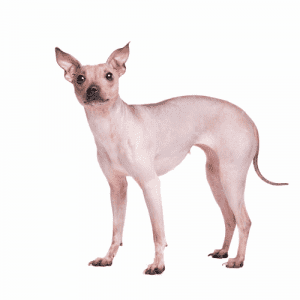


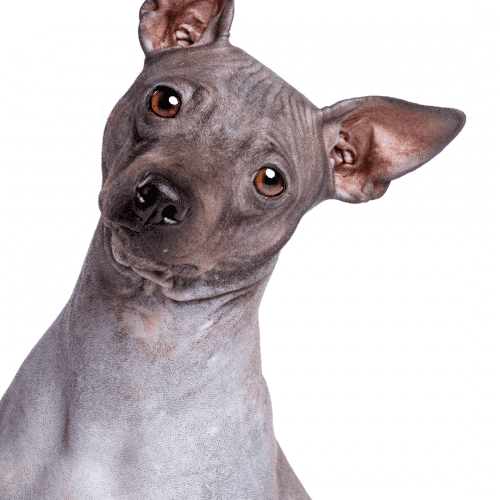
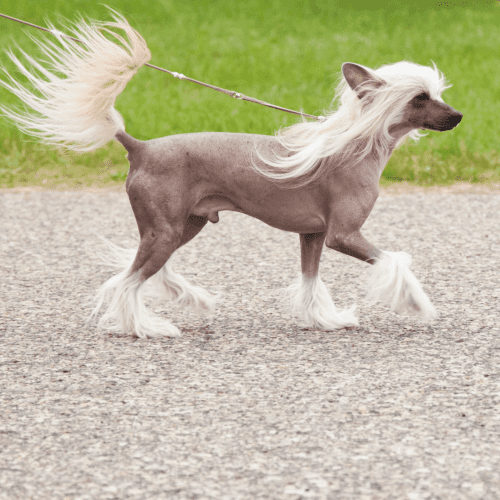
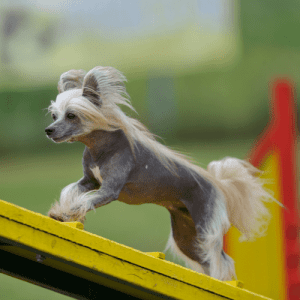
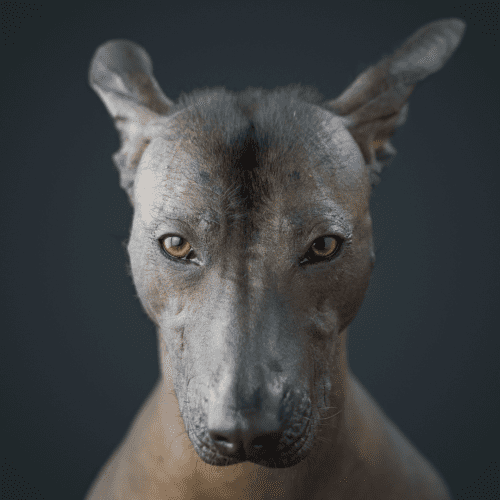

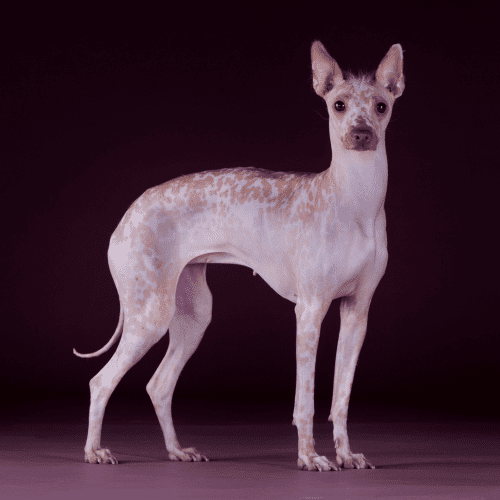

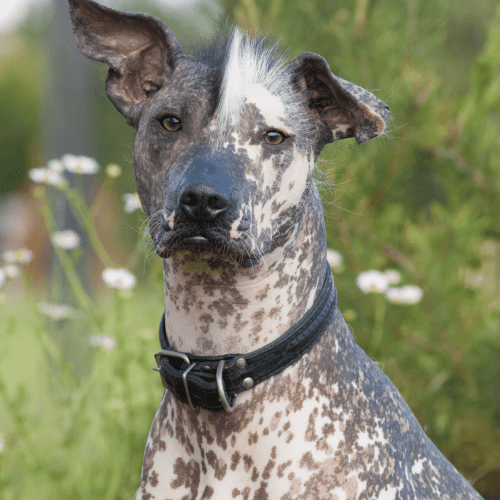
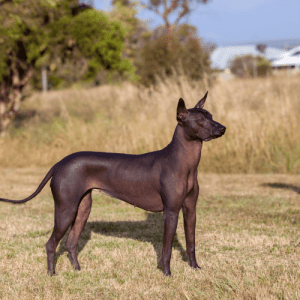 What Is The History Of The Xoloitzcuintle Dog Breed (aka Xoloitzcuintli, Mexican Hairless)?
What Is The History Of The Xoloitzcuintle Dog Breed (aka Xoloitzcuintli, Mexican Hairless)?